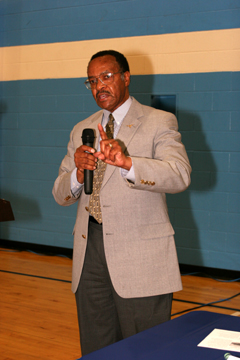 The place was noisy as well, not from a ball bouncing off the wooden court, but from voices booming over a sound system that seemed to have been turned up to ten. About a hundred people showed up in the gym last week to hear a quintet of candidates for the city council seat representing District 5, an L-shaped piece of real estate that extends from the poverty-stricken Stop Six neighborhood to the historic Handley area, and then all the way north and east to the American Airlines headquarters at CentrePort near DFW Airport. One-term incumbent Donavan Wheatfall isn’t seeking re-election. In some ways, the issues discussed were much the same as those in other areas of the city: good police protection, better zoning, code enforcement for rundown buildings, and social programs for the less fortunate. The difference was in the underlying agenda: Here, the candidates agreed that District 5 is treated like the city’s bastard child, put at the back of the line for even the most basic programs.
The place was noisy as well, not from a ball bouncing off the wooden court, but from voices booming over a sound system that seemed to have been turned up to ten. About a hundred people showed up in the gym last week to hear a quintet of candidates for the city council seat representing District 5, an L-shaped piece of real estate that extends from the poverty-stricken Stop Six neighborhood to the historic Handley area, and then all the way north and east to the American Airlines headquarters at CentrePort near DFW Airport. One-term incumbent Donavan Wheatfall isn’t seeking re-election. In some ways, the issues discussed were much the same as those in other areas of the city: good police protection, better zoning, code enforcement for rundown buildings, and social programs for the less fortunate. The difference was in the underlying agenda: Here, the candidates agreed that District 5 is treated like the city’s bastard child, put at the back of the line for even the most basic programs.
“The city has created a monster out here, and that monster is about to blow up,” said Melinda Hamilton, president of the Carver Heights East Neighborhood Association, one of the sponsors of the candidate forum. “Our district is the worst one in the city by far. There is money for all other parts of the city, but none for over here. And it seems [Mayor Mike Moncrief] loves just having all these neighborhood associations fighting for the scraps. Because if you are divided, you don’t have the power.” But some might say the monster is being created throughout the city. Many voters are feeling left out of the political discussion in Fort Worth for a variety of reasons. With city council districts ballooning in population, the voice of the average citizen seems to be getting watered down — especially since the districts have been drawn to maximize the influence of downtown and to dilute the power of any voting bloc based on ethnicity or income levels. And then there’s the election date — always a spring Saturday, which some believe is a major factor in giving Fort Worth one of the lowest voter turnout records in the country for municipal balloting.
Those factors feed off one another: Low turnout means less campaigning, less campaigning means less discussion of issues, less discussion of issues leads to a feeling among citizens that their votes don’t matter. So fewer of them go to the polls, and the downward spiral continues. Those factors might also help explain another trend in Fort Worth: the 200-plus neighborhood associations that have sprung up across the city, as residents look for other ways to have a say in local government. In a sample of cities with a similar population, none had even half as many such groups. The upside of all this is that citizens are starting to take charge of what’s going on in their immediate part of town. The downside is that some associations have become little fiefdoms dominated by a few homeowners imposing their will on neighbors and on the city planning process. The District 5 race, in fact, is a showcase for all the pressures that are driving change in the Fort Worth political landscape — the rise in the visibility (and blood pressure) of the East Side; the pros and cons of increased neighborhood-group power, the building resentment against Fort Worth’s traditional keep-it-quiet political culture, and the debilitating voter apathy that works against the other factors. That’s one reason the East Side has been left behind for so long, one black Fort Worth religious leader said recently — its politicians can’t deliver votes.
Even though District 5 is probably the most exciting race on the May 12 ballot in Fort Worth, in some places it’s hard to find anyone who knows there’s a campaign going on. “What’s one of the symbols of this city?” candidate Rickie Clark asked at the forum. “The panther — you know, the panther that slept right downtown because the city was so peaceful and quiet. Sometimes I think it is an apt symbol. Because in politics here, it is very quiet. It is sleepy time.” Clark, 46, runs youth development programs. He’s lived here for 20 years, but he grew up in Chicago, and his main issue in the campaign is getting the District 5 voters to the polls. “Whether you are on welfare or wealthy, you still are equal when it comes to voting,” Clark said. “My whole message is that if you don’t have the voters coming out in any council district, why would they ever listen to you? We can’t blame everything on other people and other parts of the city until we show over here that we have a community that takes responsibility. And voting is the best way to do that.”
During the candidate forum, Clark was bubbly and positive. But Fort Worth’s electoral system is bound to put his optimism to the test: The system has helped push voter turnout for city elections down to minuscule numbers. Many other cities around the country — Houston is one — elect their city leadership in November, when the congressional and state races are also on the ballot. The fact that Fort Worth’s spring elections are nonpartisan also reduces turnout, because the political parties don’t use their muscle to get voters out. Partisan elections with bigger fish on the ballot — especially presidential fish — boost voter turnout to the 40 to 60 percent range. Turnout in Fort Worth municipal elections is usually closer to 5 or 10 percent. Some argue that mixing national and local elections makes it harder than ever for citizens to educate themselves about the races on the ballot, resulting in local races being decided on the basis of very little voter information. But such elections do have the effect of getting more issues out in the open.
“We should hold the election in the fall,” said Sharon Armstrong, another candidate. “Some people think that we would have people voting who know nothing about the election, but I don’t think that would be the case. More people would be involved in voting, and I like to think that would be a positive.” Clark also sees the problem. “When I go out campaigning, most of the people don’t even know an election is taking place,” he said. “The media doesn’t cover it; you don’t see many yard signs. But I know why it is done this way: Fort Worth likes to keep things quiet, because [that way] the same people can get elected over and over. Low turnout is very good if you are an incumbent.” The situation is made worse by the two-city character of the local media market. Most Metroplex tv and radio stations are based in Dallas, and the ratings numbers skew toward the east. If the electronic media cover a local election in any depth, it’s more likely to be a Dallas race than one in Fort Worth.
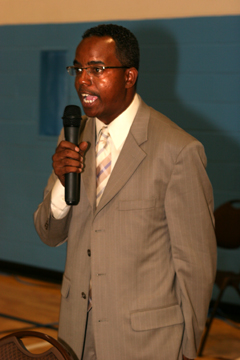 This year, with the perception that Eastsider Louis McBee’s challenge to Mayor Mike Moncrief is not a serious one, there is little drama about the top of the ballot, which means turnout may set new record lows. The parallel lack of interest by the Fort Worth Star-Telegram and radio and tv news crews has the current crop of Fort Worth city council candidates shaking their heads in frustration.
This year, with the perception that Eastsider Louis McBee’s challenge to Mayor Mike Moncrief is not a serious one, there is little drama about the top of the ballot, which means turnout may set new record lows. The parallel lack of interest by the Fort Worth Star-Telegram and radio and tv news crews has the current crop of Fort Worth city council candidates shaking their heads in frustration.
McBee, a community activist who says he’s running “to raise the issues that need to be raised in this city” wonders about the lack of coverage. “I’ve been to all of the candidates’ meetings, met with neighborhood associations, and [Moncrief] hasn’t shown up to any of them,” McBee said. “There is a mayor’s race on, but there has been no coverage in the Star-Telegram. … I know what we’ll get. A few weeks before the election, they’ll do a little story where each of the candidates will get a couple paragraphs. “But there are so many issues in this city that never get talked about, whether it’s Trinity River Vision or property tax breaks or gas drilling issues or mass transit — there are so many things that people want to talk about at all these meetings I go to,” he said. “But the way this city works, it’s all about being very quiet and not riling anyone up. “Does Moncrief talk to the Fort Worth Weekly?” McBee asked. “I bet I know the answer to that one.” (Indeed, Moncrief seldom returns calls from Weekly reporters and did not do so on this story.)
If local folks feel far removed from Fort Worth City Council chambers, forgetting and forgotten by city leaders, it’s not, as McBee said, because they don’t feel passionate about a range of issues from flooding and gas wells to buses, potholes, traffic, and encroachment in their neighborhoods. So instead, it seems, many of them have turned to another venue for exerting some control, or at least influence, over their own parts of town. Neighborhood associations, political researchers say, have moved into that political vacuum. In some parts of town they push economic development, in others they fight economic development. Some of the bigger groups may have a few hundred members, but the reality is that most are dominated by just a handful of people. And the question they raise for the city is complicated: Does having so many neighborhood associations mean the citizens have figured out a good way to protect their interests, or do they make it easier for political manipulators to pit one neighborhood, one interest group against the other? The answer, it seems, is a little of both.
“Neighborhood associations can stop almost anything they want to in Fort Worth these days,” said one local real estate developer who didn’t want his name used. “I’m not talking about huge projects like Trinity River Vision. The city makes sure they keep out of those. I’m talking about smaller housing and economic development. It’s like dealing with little mini-kings. Some of them want nothing in their neighborhoods, some of them want retail development in areas that cannot support them. But in most cases it is just a few homeowners who have more power than they know what to do with. “ Linda Morrow, president of the South Edgewood Neighborhood Association in District 5, said the city has forced neighborhood activists into these groups, because there is no other way to be heard. “There is a great need for neighborhood associations because a lot of time when we go down to city hall as citizens, no one listens to you,” she said. “Unless you come together as a group, they ignore you. And that is the same for the city staff and elected council members.”
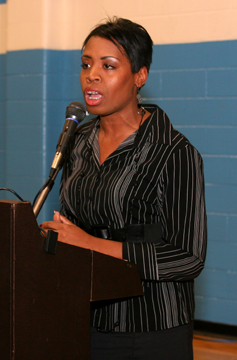 “I don’t think the neighborhood associations can have too much power,” she said. “The city needs to understand that each individual community has needs that are a bit different. In our case, on the East Side, we are always dealing with the same issues. We have an older population, and we are not the elite, and the city is always trying to push industrial areas and trashy businesses on us. We have to protect ourselves.” Five years ago, Fort Worth had 150 neighborhood groups, already far more than most cities. Now the number is 239 and still rising, with about 20 more groups joining the roster each year. In District 5, the 30 neighborhood associations wield some clout, but there is also a lot of infighting — and resentment of one fairly new group that is pushing for a historic district in Stop Six, to the dismay of those who think the idea sounds a little too much like gentrification.
“I don’t think the neighborhood associations can have too much power,” she said. “The city needs to understand that each individual community has needs that are a bit different. In our case, on the East Side, we are always dealing with the same issues. We have an older population, and we are not the elite, and the city is always trying to push industrial areas and trashy businesses on us. We have to protect ourselves.” Five years ago, Fort Worth had 150 neighborhood groups, already far more than most cities. Now the number is 239 and still rising, with about 20 more groups joining the roster each year. In District 5, the 30 neighborhood associations wield some clout, but there is also a lot of infighting — and resentment of one fairly new group that is pushing for a historic district in Stop Six, to the dismay of those who think the idea sounds a little too much like gentrification.
The city doesn’t set any criteria as to how big or small these groups might be. “We have seen a huge growth because we see so many people caring about their community.” said Angela Rush, the city’s neighborhood and community outreach manager. “I think as the city has grown, people have had issues with their neighborhoods and how they handle the city’s growth. We have encouraged them to get involved in this way.” The different role of neighborhood groups here and in other cities is evident in the numbers: In addition to the 239 neighborhood groups in Fort Worth, there are economic development organizations, multi-neighborhood alliances, and church groups — compared to 39 neighborhood associations in Atlanta, 20 in Dallas, 95 in Austin (the closest seems to be Phoenix, with 190). In some cities, community development corporations, with professional staffers, play part of the role of neighborhood groups, receiving federal block grants for various projects and services — and in some cases becoming just another way station for political patronage, slush funds, and corruption.
Fort Worth runs some of its federal grant money through a different program called “Model Blocks” that spreads about $1.2 million every two years among various projects and neighborhood groups. That puts the neighborhood groups in competition for the money. “I’m all in favor of the neighborhood associations getting more influence in the city,” said Carver Heights’ Hamilton. “But they have us competing against each other, and I think they do that to keep the fighting outside of city hall. Over here in District 5, we have some groups pushing for historic districts, some for new housing developments — some are just clubs. “But if you look at who are active members, most have five to 10 people who really do the work and are active on issues,” she said. “So what is happening is that a few people can push their views on people, and the city seems to think that is OK.” Most associations elect their officers. And though meetings are public, many groups don’t meet on a regular basis. In the Stop Six area, the neighborhood association has been pushing for a historic overlay and zoning that would allow only single-family housing. But some older residents are fighting the historic overlay, because they don’t want to have to deal with strict rules limiting repairs or changes to their properties.
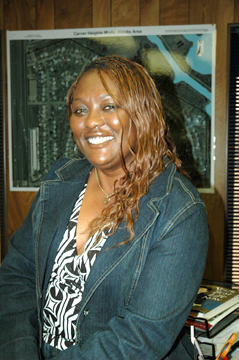 “We have a lot of elderly people in the area, and the neighborhood association pushed their own rezoning that most of these elderly residents couldn’t afford to comply with,” said Liz Sims, a Stop Six resident. “Now they are pushing for a historic district, which is going to make it even more difficult for many homeowners. Over here in Stop Six, we have a lot of properties that still have horses and chickens and goats. Those won’t be allowed. I kind of think preserving farm animals might be a part of a historic district. That’s a tie back to the older days, isn’t it?” Regina J. Blair is president of the three-year-old Stop Six Sunrise Edition neighborhood group that is advocating the historic overlay. She has a bachelor’s degree in architecture and master’s degrees in business and urban planning. She works in neighborhood planning for the City of Arlington. “We have often seen how historic districts are set up in other parts of the city, and those parts of the city get the benefit from them,” Blair said. “But every time we hear about people opposed to this, we find out they don’t know about the issues. What we want to do is protect an area of the city with a defined history in the African-American community, because we constantly see old buildings torn down and really bad new ones put up.”
“We have a lot of elderly people in the area, and the neighborhood association pushed their own rezoning that most of these elderly residents couldn’t afford to comply with,” said Liz Sims, a Stop Six resident. “Now they are pushing for a historic district, which is going to make it even more difficult for many homeowners. Over here in Stop Six, we have a lot of properties that still have horses and chickens and goats. Those won’t be allowed. I kind of think preserving farm animals might be a part of a historic district. That’s a tie back to the older days, isn’t it?” Regina J. Blair is president of the three-year-old Stop Six Sunrise Edition neighborhood group that is advocating the historic overlay. She has a bachelor’s degree in architecture and master’s degrees in business and urban planning. She works in neighborhood planning for the City of Arlington. “We have often seen how historic districts are set up in other parts of the city, and those parts of the city get the benefit from them,” Blair said. “But every time we hear about people opposed to this, we find out they don’t know about the issues. What we want to do is protect an area of the city with a defined history in the African-American community, because we constantly see old buildings torn down and really bad new ones put up.”
Blair said the neighborhood associations are growing in influence “because people are starting to recognize the importance of being involved, having a voice, and holding a council member responsible for your district,” she said. “That means you have to organize, and you have to present your voice. In the case of Stop Six, we had no voice, but those of us who are progressive in our thinking have pulled together.” Tammy Pierce, one of the District 5 candidates, said she thinks neighborhood associations may divide rather than unite the East Side. “It is a major issue because they are competing over model block money,” she said. “There are too many chiefs and not enough Indians.” Eastside community activist Norm Bermes said that neighborhood groups have grown more influential because, “The city has pushed us to the point we have no other choice. The city ignores this part of town, and the only way we can make our voice heard is to organize.” Even that hasn’t worked well yet, he said, “but we hope it will” in the future.
When Fort Worth created its eight single-member council districts in the 1960s, each council member represented about 46,000 citizens. No districts have been added since then, but in one of the fastest-growing cities in the country, voters certainly have been. In fact, with an average population of 80,000, Fort Worth’s council districts are among the largest of any comparably sized city in the country. With that many people, few council districts are homogenous or anything like it. Councilman Sal Espino’s Northside district, for example, runs from the Radio Shack headquarters to beyond the Texas Motor Speedway. He represents poorer Hispanic communities on the North Side, the Stockyards area, expensive new homes in the Alliance Airport corridor, newly annexed properties in Denton County — and, like almost every other council member, part of downtown. “The way the districts are drawn now, it is almost impossible to represent all the varied interests without pissing off some of them,” said one council member, who didn’t want to be named. “I’m not surprised that all these neighborhood associations have sprung up, because the council members have so many different constituents.”
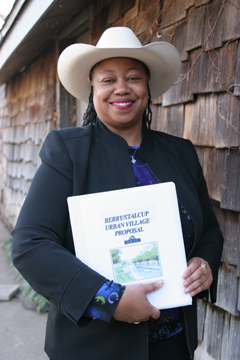 Armstrong pointed out that District 5 “runs all the way out to the airport. “We need better-defined districts,” she said. “You can’t represent Mosier Valley and Handley and Stop Six and American Airlines at the same time. But maybe that’s how the city wants it. They make it hard to represent anyone.” District 5 candidate Lonnie Woods, an attorney, agreed. “We really need to add districts and define the boundaries better,” he said. “One of the things Fort Worth needs to do is manage its growth. And part of that is managing growth so people still have good representation. We are growing as a city, but the average citizen is getting less influence. That needs to be addressed.” Neighborhood groups, district boundaries, voter apathy — all those topics came up at the District 5 forum. But the main issue, voiced again and again, was the feeling that the East Side is still fighting for leftovers from the table of the wealthy and the politically connected. “If you want to look how we rank in all sorts of categories, we rank highest in so many of them,” Armstrong told the crowd. “We rank highest in crime and poverty and housing problems and the lack of job opportunities. But for some reason, when it comes to help in fixing these problems in our community, we rank last in getting money from the city.”
Armstrong pointed out that District 5 “runs all the way out to the airport. “We need better-defined districts,” she said. “You can’t represent Mosier Valley and Handley and Stop Six and American Airlines at the same time. But maybe that’s how the city wants it. They make it hard to represent anyone.” District 5 candidate Lonnie Woods, an attorney, agreed. “We really need to add districts and define the boundaries better,” he said. “One of the things Fort Worth needs to do is manage its growth. And part of that is managing growth so people still have good representation. We are growing as a city, but the average citizen is getting less influence. That needs to be addressed.” Neighborhood groups, district boundaries, voter apathy — all those topics came up at the District 5 forum. But the main issue, voiced again and again, was the feeling that the East Side is still fighting for leftovers from the table of the wealthy and the politically connected. “If you want to look how we rank in all sorts of categories, we rank highest in so many of them,” Armstrong told the crowd. “We rank highest in crime and poverty and housing problems and the lack of job opportunities. But for some reason, when it comes to help in fixing these problems in our community, we rank last in getting money from the city.”
That kind of anger isn’t being kept under a lid in Fort Worth the way it used to be. This city for many years has done its business quietly, and those who spoke up got punished, especially in minority areas. The feeling among older African-Americans was that in order to get even the leavings from Westside tables, the prudent approach was to work quietly behind the scenes and follow the established rules. That has led Dallas African-American leaders to refer to their Fort Worth brethren as Uncle Toms and Aunt Jemimas. That difference in philosophy — working quietly to get part of a loaf or raging publicly against the empty breadbox — was much in evidence at the forum, and the split tended to be along age lines. “This community is flat-lining,” said Tammy Pierce, 36, who works in the financial department for Daimler Chrysler. “We are dying. But nothing has happened over here for more than 40 years. We need someone on city council who stands up for this community, and not the old guard who plays by the old rules. Because the old rules don’t work.”
Frank Moss, 62, the real estate broker who served on council for six years before getting defeated by Wheatfall in 2004, not surprisingly took the other side. “In order to get anything done here, you need to have five votes on city council,” he said. “You need experience to know how to do that, and working together is how we all can get things done.” Walk or drive through District 5, and it’s not hard to understand why residents feel ignored. Vacant lots are everywhere, retail shopping is sparse, and much of the housing is older and in bad shape. And yet, District 5 residents don’t have to look far to see how different things might be. Across Mitchell Boulevard in District 8, the future’s looking brighter. After Kathleen Hicks was elected from District 8 in 2004, she made it one of her priorities to get economic development going in a part of the city that had been ignored in the past. Now, the Sierra Vista development with 200 new homes is replacing the abandoned Riverside Village Apartment complex, and the old Masonic Home and School property is being transformed into 500 new homes and a retail center. And she is unopposed for re-election this year. The lesson is not lost on the District 5 candidates.
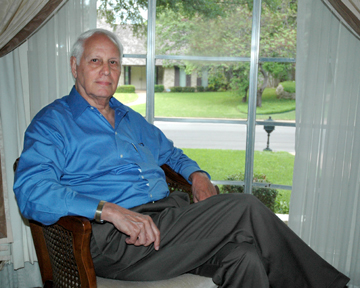 “Kathleen has done a fantastic job in District 8, and in some respects we are jealous,” said Armstrong. “But in some ways people might see what is happening there and see some hope. … We can do it, too. We just haven’t had the right leadership.” Not that Hicks’ success answers all the questions for the rest of the East Side: She backs Moncrief on most matters, and that had led to her appointment as Mayor Pro Tem. Hicks does not remain quiet on issues that involve race and poverty, but she does carefully pick her battles. Early in her political career, Hicks has garnered the reputation of one who carefully blends the quiet behind-the-scenes approach with occasional public anger. Pierce said Hicks “speaks up for her district, and she does an effective job. … If it wasn’t for her, we’d have more trouble over here.” Donavan Wheatfall, the lame-duck incumbent, is taking a lot of the blame these days for the bad things happening and the good things not happening in District 5. He was out of the country this week and unavailable for comment.
“Kathleen has done a fantastic job in District 8, and in some respects we are jealous,” said Armstrong. “But in some ways people might see what is happening there and see some hope. … We can do it, too. We just haven’t had the right leadership.” Not that Hicks’ success answers all the questions for the rest of the East Side: She backs Moncrief on most matters, and that had led to her appointment as Mayor Pro Tem. Hicks does not remain quiet on issues that involve race and poverty, but she does carefully pick her battles. Early in her political career, Hicks has garnered the reputation of one who carefully blends the quiet behind-the-scenes approach with occasional public anger. Pierce said Hicks “speaks up for her district, and she does an effective job. … If it wasn’t for her, we’d have more trouble over here.” Donavan Wheatfall, the lame-duck incumbent, is taking a lot of the blame these days for the bad things happening and the good things not happening in District 5. He was out of the country this week and unavailable for comment.
The young owner of a computer software company came out of nowhere to defeat Moss in 2004, and many thought he had the zeal to pull the area out of its doldrums. But most think Wheatfall didn’t live up to his promise. Most of his would-be replacements say Wheatfall got elected promising change, then fell back with the old guard, specifically the Leonard Briscoe family, an African-American real estate development clan with government ties going back to the 1960s. “Wheatfall has let this community down,” said Armstrong. “I worked on his campaign, and we supported him because we thought he would be the right kind of change. But he stopped listening to anyone besides the Briscoes. He pushed the historic designation for Stop Six, and then pushed code compliance that was often a harassment tool. We had senior citizens who had the choice of taking their medication or paying a [code violation] fine. We needed a council member who could work with us, and Wheatfall stopped doing that very soon after he got elected.”
Leonard Briscoe has said that he and his family company have only worked to be treated fairly in the city, with the same sort of tax breaks and city incentives given white developers. Wheatfall, Briscoe said, was merely working on behalf of economic development in the community. Community activist Sims said Wheatfall also got overwhelmed by some of the very specific interests of all the District 5 neighborhood associations. “Wheatfall started out very good, and then the neighborhood associations got in his face over everything, and he was only listening to what they wanted,” she said. “Wheatfall stopped listening to all of the people in this district.” Wheatfall became known on the city council for a different characteristic, however. He showed up late for many meetings or didn’t show at all. When candidate Woods showed up a half-hour late for the candidate forum last week, one member of the audience commented dryly that “he has the same characteristics of our current councilman.”
The problems in District 5 are simple to describe but hard to solve. Police protection has improved, but the enforcement of building codes by the city seems to occur almost at random. Some falling-down houses have yards full of ancient trash; others just as old are pristine and look like they could be dropped comfortably into a historic area like Ryan Place. But the main issue seems to be economic development. District 8 was able to bring in new retail and business development only after plans for new housing were approved. Moss said that needs to be a starting point. “The investors are looking at the number of new rooftops and the income of those residents before they come in,” he said. “And we need the city to start the process and get the housing developers in here.” The question is whether the district, with city hall’s help and a new member on the council, can reverse the downward spiral — in voter turnout as well as in things like housing and business development.
“Nothing’s being done well over here,” said Morrow. “We’ve been promised economic development and decent housing, and so far all we get are cheap shotgun houses. No retail developers come in here, and I doubt whether the city has even approached anyone. Do we have good representation? Whether it is Wheatfall or Moss, the answer is still the same: I see an area with a lot of history here, but I don’t see the city council people enriching this part of town. It’s almost as if we don’t exist.” Hamilton agreed. “We all supported Donavan, and he did all he could do. The mayor is running the city, the neighborhoods aren’t. That’s what we are trying to change.” Moncrief, in his state of the city address earlier this year, said 2007 was going to be the “year of the neighborhoods.” Whether he meant all 239 or only a select few is tough to decipher.
Bermes said it is impossible to figure out what Moncrief wants to do because he never comes to any neighborhood meetings on the East Side. The mayor “doesn’t show up or talk about issues. It’s as if he assumed he has already won.” said Bermes, who heads the Fort Worth Citizens for Responsible Government organization and has been McBee’s ally in many fights. This year the election falls on the day before Mother’s Day — maybe another reason for voters to stay home. As the Rev. Buck Cass said after the forum, “just about every woman will be at the beauty parlor that day getting their hair done. Either that, or out of town visiting their mother.” With five candidates in the race, a runoff is a sure bet — and in a district with almost 80,000 residents, it will probably take only about 400 votes to get there.
In some respects, that’s where the fight for District 5 really starts. After that, the fight will be for the winner to find a way to change the future here — playing by the old Fort Worth rules or chucking them out the window, working with the neighborhood groups or against them, making new allies or keeping the ones that haven’t produced that much for the district in the past. And maybe finding new ways to improve those turnout figures. Because, as Clark said, “If you don’t vote, then don’t complain about how you lose the fights down at city hall.”
You can reach Dan McGraw at dan.mcgraw@fwweekly.com.











